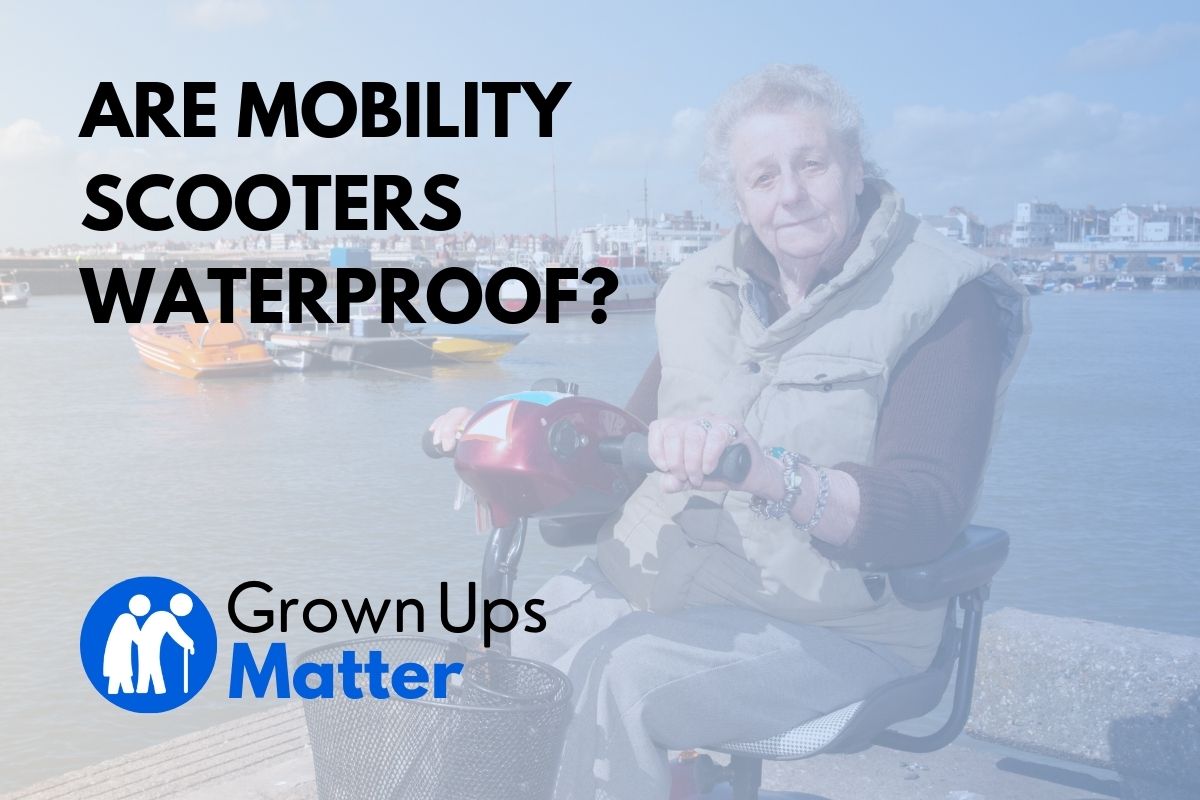Many of us might have wondered about the water resistance of mobility scooters, especially when it comes to sudden showers or a wet day outdoors.
Mobility scooters are key to maintaining independence and mobility, and knowing how much water exposure they can handle can significantly contribute to their longevity and durability.
The question “Are mobility scooters waterproof?” is complex and has several dimensions.
It encompasses aspects from the design and engineering of the mobility scooter, all the way to its usage, maintenance, and the weather conditions it’s exposed to.
By understanding these aspects, you can make more informed decisions and enhance your experience with your mobility scooter.
To answer the question at hand and dive into the specifics, let’s break down the concept into key takeaways, followed by a deep dive into each of these facets.
Key Takeaways
- Mobility Scooters are not Fully Waterproof: While mobility scooters can withstand light rain and small amounts of water, they are not completely waterproof. Prolonged or heavy exposure to water can damage the electrical systems, leading to malfunctions.
- Understand Your Scooter’s Limitations: It’s essential to know how much water exposure your mobility scooter can handle. Avoiding water hazards and keeping your scooter dry can significantly increase its lifespan.
- Immediate Action for Wet Scooters: If your scooter does get wet, immediate action can prevent severe damage. Disconnect the batteries, dry off the surfaces, and consider professional maintenance to ensure full recovery.
- Waterproofing Measures: You can take measures to increase your scooter’s resistance to water, including using scooter covers and waterproof clothing for your scooter’s control panel.
- Waterproof Mobility Scooter Options: There are mobility scooters with improved water resistance on the market, which might be worth considering if you live in a wet climate.
Mobility Scooters Are Not Waterproof but Can Get Wet
It’s important to realize that while mobility scooters are designed to be sturdy and durable, they are not completely waterproof. That said, most mobility scooters are designed to handle a certain degree of water exposure. The exact level of water resistance can vary between different models and manufacturers. If you’re interested in understanding the different types of mobility scooters and their specific features, this comprehensive guide on types of mobility scooters can be a valuable resource.
Light rain, splashes, and small amounts of water are unlikely to cause significant damage to a mobility scooter. This is because key components, such as the motor and battery compartment, are usually shielded from water ingress. However, prolonged exposure to water or heavy rainfall can potentially seep into these components and cause malfunction. Similarly, submersion in water, even for a short time, can be catastrophic for a mobility scooter.
It’s essential to realize that mobility scooters are not just about the scooter itself but also about the electronic components that make it run. These components are sensitive to water, and damage from moisture can lead to serious and costly repairs, which can be a real concern for many users. For more information on potential problems and solutions, check out this comprehensive mobility scooter troubleshooting guide.
By understanding these constraints, we can take appropriate precautions and maintain our mobility scooter in optimal condition for a long time. With the right care, a mobility scooter can be a reliable partner for many years of independence and mobility.
How Wet Can a Disability Scooter Get?
As we’ve already established, most mobility scooters are not waterproof. However, they’re designed to withstand a certain degree of moisture, which is important for their day-to-day functioning.
You might wonder, ‘How wet can a mobility scooter get?’
Well, it’s hard to specify exactly how much water exposure a mobility scooter can handle before it starts to malfunction. The level of water-resistance will vary from model to model. However, most manufacturers design scooters to cope with light rain or accidental splashes.
When thinking about water resistance, it’s worth considering a scooter’s IP rating. This is a standard that rates the degree of protection against intrusion from solids and liquids. If your scooter has a high IP rating, it’s likely to resist water better than a scooter with a lower rating.
Nonetheless, continuous exposure to heavy rain, water puddles, or high levels of humidity can potentially damage the electronics of your mobility scooter. The battery and the control panel are especially vulnerable.
What to Do If Your Scooter Got Wet?
If your scooter got wet, it’s essential to respond promptly to prevent permanent damage.
- First, move your scooter to a dry place. This will help prevent further water exposure.
- Switch off the scooter. If the control panel or the battery has gotten wet, switching it off can prevent short circuits.
- Wipe down the scooter thoroughly with a dry cloth. Pay special attention to the control panel and battery area.
- Let it dry naturally. Do not use a heat source to dry your scooter, as it can cause damage to the electrical components.
- Check for functionality. Once your scooter is completely dry, switch it on and check for any operational issues. If the scooter doesn’t work or functions improperly, you might need professional assistance.
Even if your scooter is working fine, water exposure might still have long-term effects. So, it’s essential to keep an eye out for any signs of damage. Our comprehensive guide on mobility scooter troubleshooting can be of immense help.
Repair Water Damage on a Personal Scooter
If your scooter suffers from water damage, don’t panic. There are professional services that can help you repair your scooter. If you have mechanical skills, some issues can be resolved at home with a detailed mobility scooter repair guide.
Remember that if water has seeped into the electronic components, such as the motor or control panel, you’ll likely need professional help. Always ensure to check your warranty before attempting any repair by yourself, as unauthorized repairs might void it.
Waterproofing Your Scooter
Although most scooters aren’t fully waterproof, there are ways to increase their water resistance. Here’s how you can waterproof your scooter:
- Protective Covers: Use protective covers for the seat, control panel, and basket. These covers are affordable, easy to use, and provide a significant amount of protection against rain.
- Maintenance: Regular maintenance is key. Make sure all the parts are well lubricated to prevent water from seeping in.
- Storage: Always store your scooter in a dry, enclosed space to protect it from the elements.
Also, consider investing in mobility scooter maintenance to keep your scooter in top shape.
Best Waterproof Mobility Scooters
While no mobility scooter is entirely waterproof, some models offer better water resistance than others. Here’s our top picks:
- Pride Mobility’s Go-Go Elite Traveller: Known for its strong build and durability, the Go-Go Elite Traveller can withstand light to moderate rain without a problem.
- Drive Medical’s Scout Compact Travel Power Scooter: This scooter’s anti-tip wheels and sturdy design make it a reliable choice in wet conditions.
- Golden Technologies Buzzaround EX: With a range of up to 18 miles, the Buzzaround EX offers excellent performance and better water resistance than most models.
Remember that even with these models, exposure to water should be minimized to protect the scooter’s longevity. Check out our detailed mobility scooter buying guide for more options.
Can Waterproof or Rain Certified Scooters Go Underwater?
It’s important to clarify that no mobility scooter, no matter how well-rated for water resistance, should ever be submerged in water.
Despite their ability to cope with rain, scooters are not designed to be underwater.
The battery and electrical components are particularly vulnerable, and exposure to water can cause severe damage, often irreparable.
So while some scooters can handle a bit of rain, they should never be driven through deep puddles, left out in heavy rain, or left in areas susceptible to flooding.
Your scooter’s health, as well as your safety, is paramount.
All the claims made in this article are only for informational purposes, based on the writer’s experience and not clinical advice. You should always consult your physician or physical therapist if you have any doubts about how this applies to your specific case.

Rami is an economist with a passion for personal finance and a desire to help people make the most of their retirement years. He’s also the tech mind that made all of this possible, and a marketing enthusiast. In his articles, Ramiro offers real-life advice and resources for seniors looking to manage their finances and make the most of their retirement savings. He is dedicated to helping his readers live comfortably and securely during their golden years.

